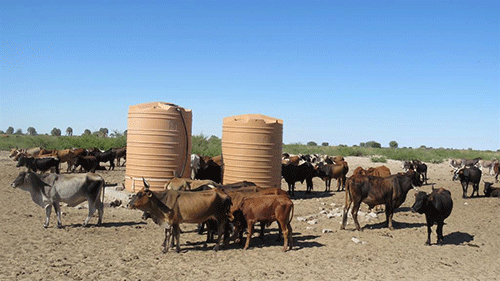Farmers in the Eiseb area of the Omaheke region, which boost one of the highest concentrations of poisonous plants, such as the gifblaar, have started their annual migration of livestock to safe areas.
Eiseb is a large tract of land on the periphery of the Omaheke region, stretching from the Otjombinde constituency to the remote areas of Epukiro and Otjinene constituencies.
Farmers have, for years, been flocking to Eiseb in search of much-needed grazing for the livestock.
Due to the presence of different varieties of poisonous plants, however, farming in the area has been a daunting task.
The gifblaar, which accounts for most deaths of livestock from poisonous plants, grows in large areas of Eiseb during the dry winter months.
It naturally withers and dies out at the onset of the first rains of summer.
This means that from July to September, the Eiseb area becomes risky for farmers with livestock there.
As a result, some farmers have opted to transport their most vulnerable livestock back to areas of safety, such as Otjinene and Epukiro, proper this time until the gifblaar dies out.
It is a costly and strenuous exercise, as young farmer Nelson Tjituka puts it.
He, however, remains adamant that it is a route he will take any day, despite its cost implications.
“It is not an easy exercise. Transporting several animals by car to far laying areas is costly, but this is what we do here. The Eiseb area has now become home to most of us, and we cannot permanently move away from here. So, it’s a little bit of a difficult situation to decide which death is easier for the livestock: by drought in overgrazed areas of Epukiro or through the gifblaar,” he said.
Tjituka said most farmers are used to the migration, during which a farmer may move up to 30 animals back to safety.
The animals are usually moved back to areas where the farmer originally hailed from before moving to Eiseb.
Another farmer Gerson Karamata said he was at first reluctant to move his livestock back and forth between his current residence at Eiseb and his former village in the Otjinene constituency.
However, after losing several animals some three years ago to poisonous plants, he decided otherwise.
“The cost of moving these animals back to safer areas is nothing, compared to the astronomical loss you will encounter when five to seven of your best livestock fall dead in front of you due to these poisonous plants,” he said.
Karamata added that farming is a risky and costly business; therefore, one must be prepared to shoulder the cost of moving the animals. It is all about taking calculated risks – not hasty decisions, he said.
For most elderly farmers, such as Ewaldt Rukero, it is pointless moving to an area such as Eiseb and then migrate livestock between villages.
“It is a futile exercise in my eyes. If you have decided to relocate to Eiseb due to the good grazing in the area and the peace of mind it gives you, then be prepared to pay the small price of such freedom. The young ones are full of energy for things like that – but for us, we have grown accustomed to what life throws at us,” he said.
Many, such as Rukero, have opted instead to clear their areas of the gifblaar by trying out different remedies – many of which have been unsuccessful in completely ridding the area of the gifblaar.
But there is no giving up for them, Rukero said, noting that one never runs away from your home when it is on fire.
“If your home is on fire, you try all means to put out the fire. You do not flee to your neighbour, fold your legs on a chair and enjoy a cup of tea through your tears. You fight for your home. That’s all we do,” he said.
– tjatindi@gmail.com


